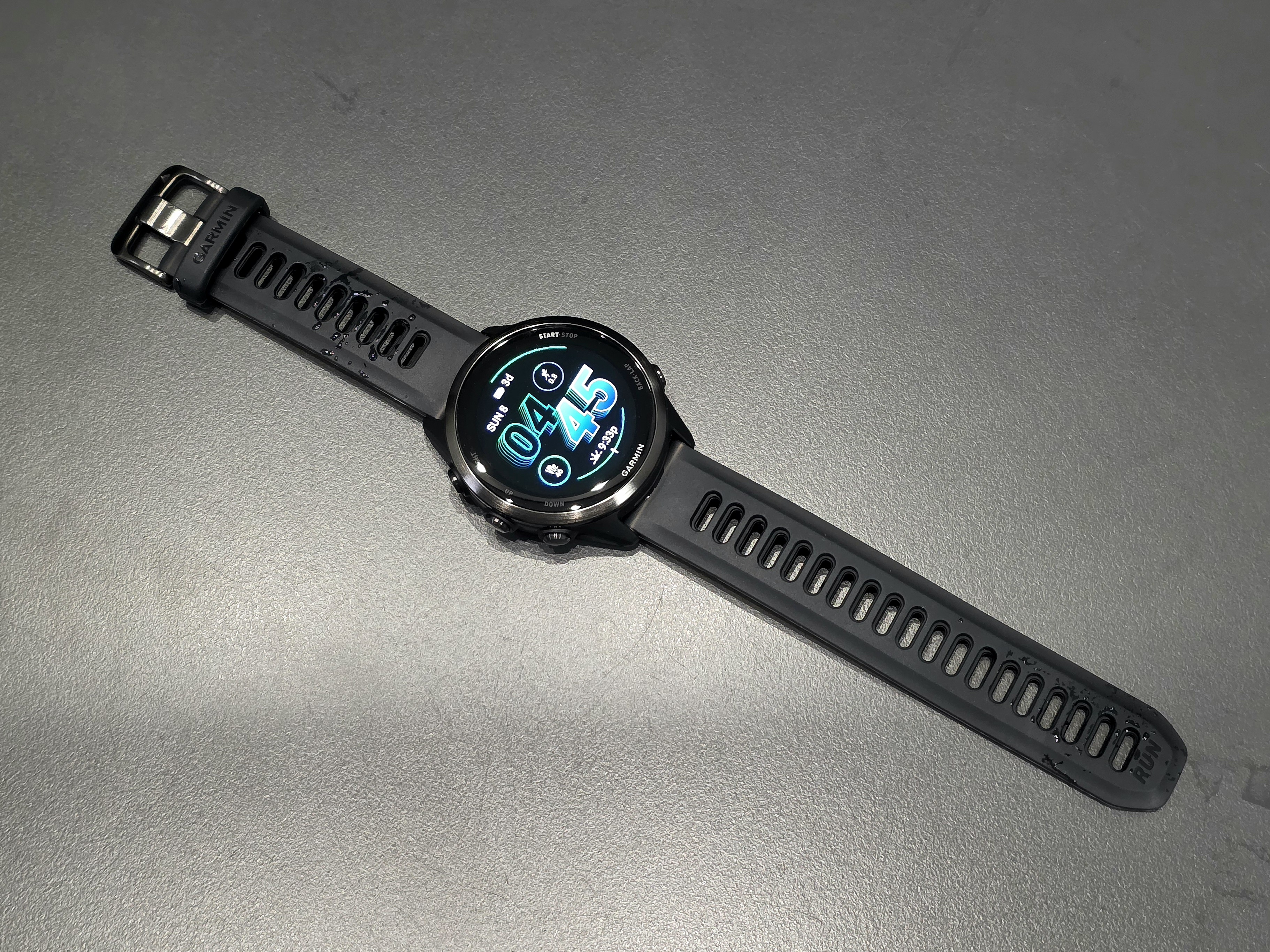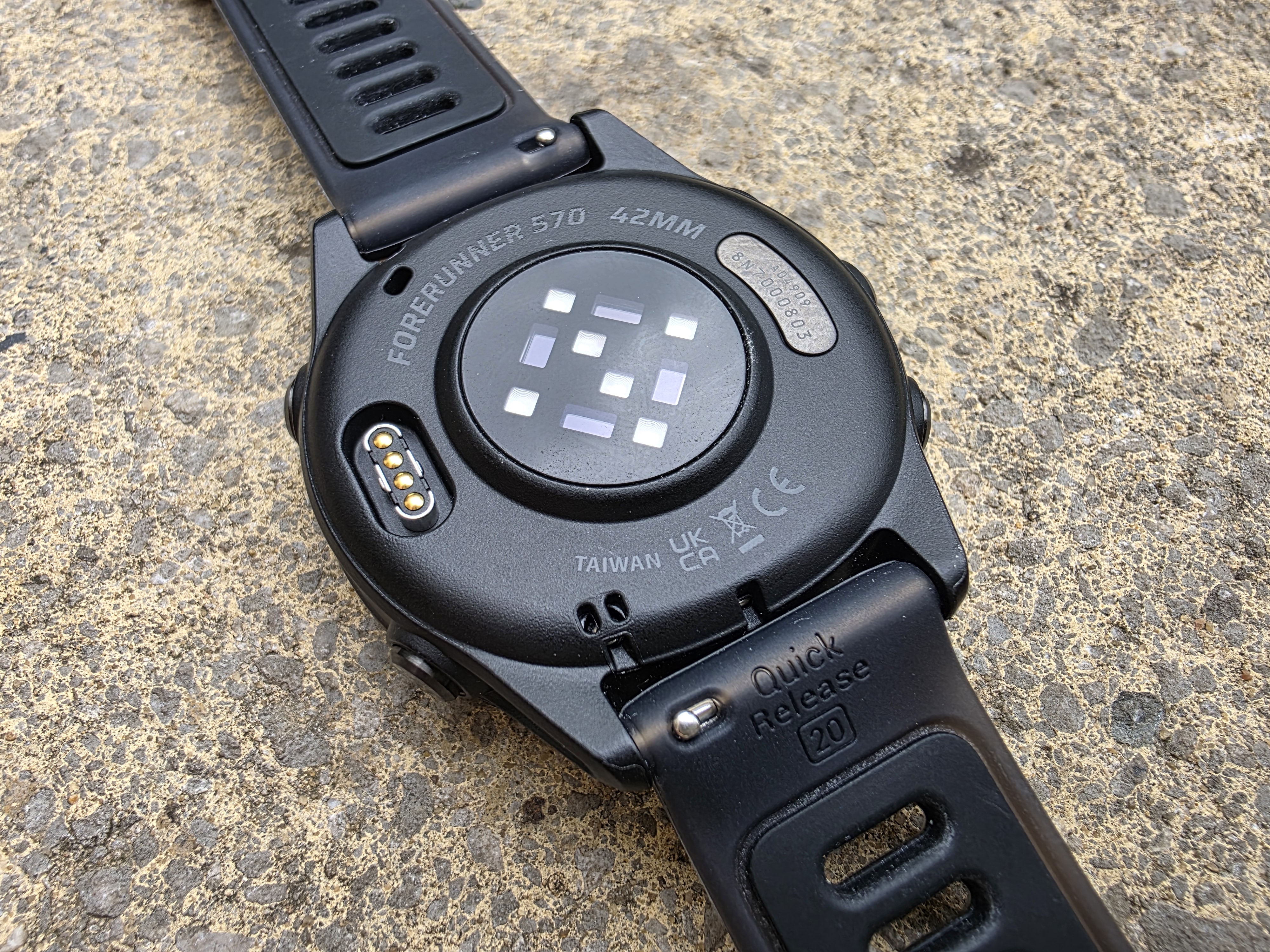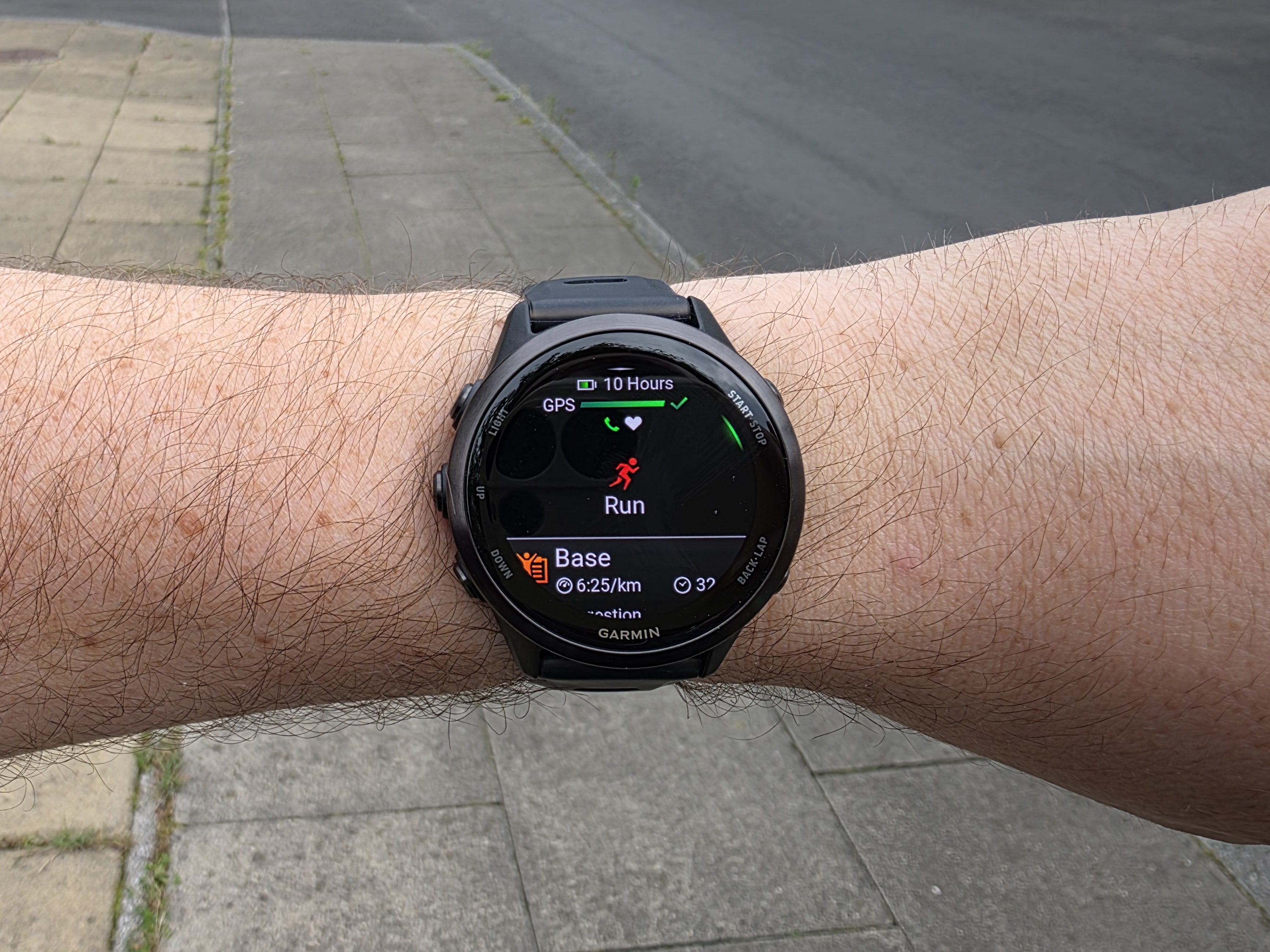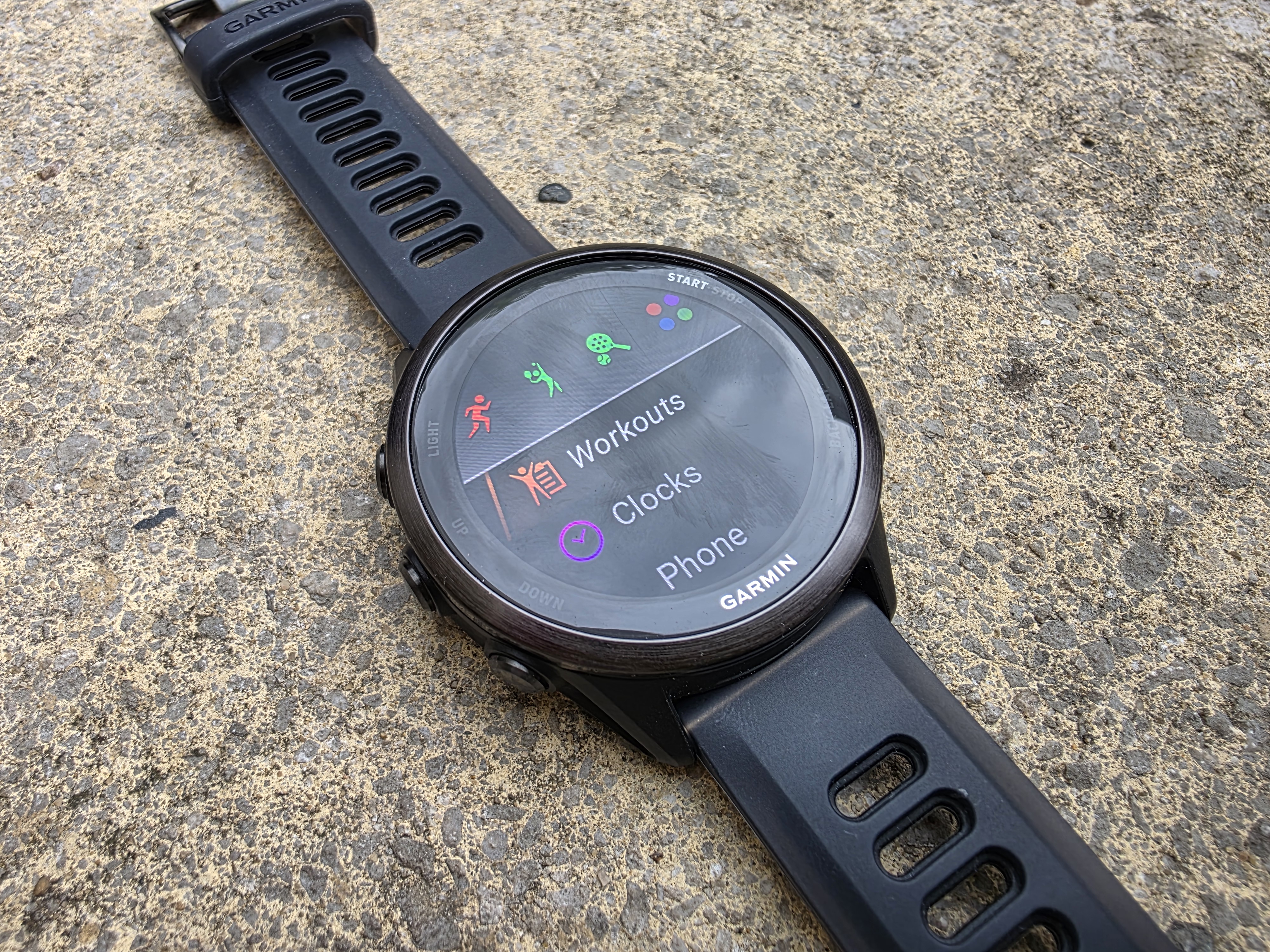TechRadar Verdict
The Forerunner 570 is a slick, elevated version of Garmin’s best mid-range watch. It’s a sharp, lightweight and feature-rich sports tracker with the right smarts for runners and training fans. Despite touting the top-notch tools Garmin’s known for, it feels more like a refinement than a reinvention, and – with such an expensive price tag – that might not be quite enough for some.
Pros
- +
Brightest and most vibrant AMOLED screen yet
- +
Aluminium bezel and colourful design options
- +
Elevate v5 heart rate sensor is accurate
- +
Built-in mic and speaker for calls and voice assistant
Cons
- -
High price for same feature set
- -
No ECG functionality despite new sensor
- -
Battery life has taken a hit
- -
Still no offline maps
Why you can trust TechRadar
Garmin Forerunner 570: One minute review
The Garmin Forerunner 570 is a solid, stylish upgrade to what’s long been Garmin’s best running watch. It’s no revelation by any means, but it is a welcome refinement and for the right person, that might be enough.
In short, this is the Forerunner that finally looks the part. It swaps out the safe, functional aesthetic of older models for something bolder and a bit more expressive. Between the colorful two-tone straps and sleek aluminium bezel, the 570 is easily the most fashion-forward Forerunner to date. If you’re not into raspberry and turquoise combos and prefer to play it safe, a plain ol’ black option still exists.
The real highlight, though, is the new AMOLED display. It’s bigger, brighter and sharper than what came before, and makes the whole interface feel slicker and more modern. It’s the kind of screen you’d happily gaze at all day, whether checking your stats, skimming a notification, or seeing what’s playing on Spotify.
Performance-wise, this is still a Garmin device through and through. It tracks over 90 sports, handles GPS and heart rate with accuracy, and delivers all the in-depth training insights you could possibly need. The new Elevate v5 heart rate sensor performs particularly well, even during interval workouts, and feeding into metrics like Training Readiness.
There’s also a subtle push into smartwatch territory. You can now take calls from your wrist, trigger your phone’s voice assistant, and hear alarms or music through the built-in mic and speaker, all of which you couldn’t do on previous Forerunners. These are handy additions for day-to-day use.
The downsides? They’re not huge, but they’re worth noting. Battery life is down slightly from previous models thanks to that power-hungry AMOLED display, and while Garmin’s added polish, it hasn’t added any major new features. There’s no ECG, no offline maps, and nothing particularly game-changing on the software front. And now, Garmin Connect’s richer insights – like advanced sleep and adaptive training plans – are hidden behind a monthly subscription, which stings a bit after paying nearly $549.99 / £460 / AUD$999 for the watch itself.
All in all, the Forerunner 570 is top-notch. It’s not groundbreaking by any means, and it won’t be for everyone – especially if you already own a recent Garmin – but it’s a confident step forward for the series. After almost a month of daily wear, I consider it a strong choice for runners and multi-sport users who want a more stylish training companion that still does the basics exceptionally well.
Sign up for breaking news, reviews, opinion, top tech deals, and more.
Garmin Forerunner 570: Price and availability

- Availability: Buy now worldwide in two sizes (42mm and 47mm)
- Price: From £459.99 / $549.99 / AU$999
- Colors: Multiple colorways
The Garmin Forerunner 570 launched in May 2025 and is available directly from Garmin as well as most major retailers in two case sizes – 42mm and 47mm.
This time 'round, Garmin has injected some seriously snazzy colors, which have never been seen before in the series and are certainly more loud and playful. While my test model is the straight-up black for those who want to keep things minimal, there are some fruitier-named options to choose from, such as a Raspberry Aluminum with a Translucent Bone/Mango band, Amp Yellow Aluminum with a Translucent Whitestone/Turquoise combo, or Indigo Aluminum with Translucent Imperial Purple/Indigo Band.
They’re pretty out-there, and I can imagine they’ll divide opinion among potential customers, but from what Garmin has said, that’s the point.
At $549.99 / £459.99 / AUD$999, it’s firmly into upper mid-range territory. That’s £30 more than the Forerunner 265 cost at launch, and significantly more than competing watches like the Suunto Race S ($349 / £325 / AU$599) or Coros Pace Pro (£349.99 / $450 / AU$690), which offer features like offline maps and longer battery life at lower prices.
There’s also an added consideration now with Garmin Connect’s recently introduced subscription model. Previously free features such as advanced sleep tracking, adaptive training plans and full HRV trend analysis are now part of Garmin Connect Plus; a paid tier costing from £6.99 / $6.99 per month.
While you can still sync workouts, view metrics and access your training history on the free tier, the move has drawn plenty of criticism from long-time users, particularly those paying premium prices for hardware like the Forerunner 570. For many, that monthly fee will be worth it for the richer data and personalized feedback, but it’s still a frustrating shift, especially for new buyers who expect those features to be included as standard after forking out for a very expensive watch!
- Value score: 3 / 5
Garmin Forerunner 570: Design

- Premium-feeling aluminum bezel
- Colourful strap options make it more appealing
- AMOLED screen is bright, vibrant and sharp
It’s fair to say Garmin’s never been one to push the boundaries when it comes to design, but the Forerunner 570 finally dares to break tradition, at least to some extent. In my opinion, this is the most stylish Forerunner to date, thanks to its vibrant color options and new aluminum bezel that upgrades what has traditionally been Garmin’s focus on functionality over form.
Quite ironic, then, that my review device was the smaller 42mm model in the bog-standard black variety, which looks just like any other Garmin watch. Still, the display is the star of the show here anyway.
The Forerunner 570’s 1.2in AMOLED panel is a stunner. Its resolution of 390 x 390 pixels is super crisp, colorful and bright enough to read, even in strong sunlight, and especially when displaying data screens or notification previews.
Despite the big display, the Forerunner 570 stays comfortable for all-day wear. It weighs just 50g (47mm) or 42g (42mm), and the silicone straps feel soft and comfortable on the wrist. Some models also feature slightly translucent straps, a subtle design touch that helps elevate the overall sporty aesthetic.
The traditional five-button Forerunner layout returns, alongside touchscreen controls. The buttons aren’t quite as tactile as those on Garmin’s chunkier Fenix line, but they’re still reliable and work well during sweaty sessions. There’s now also a speaker and mic on board, discreetly integrated into the sides of the case – but more on that later.
- Design score: 4.5 / 5
Garmin Forerunner 570: Features

- No major new software tricks
- Grouped glance folders improve on-watch UX
- Speaker and mic add a lifestyle smartwatch vibe
The Forerunner 570 brings very little that’s new in terms of features and that might disappoint some. Most of its tools and widgets already exist elsewhere in Garmin’s ecosystem, especially on the older Forerunner 265 and 965 devices. But what it does, it does very well.
Glance folders are now enabled by default, giving you smarter access to related stats like Body Battery, HRV, sleep and training readiness, which helps reduce the scroll-fatigue that often plagues Garmin watches. You can create your own, too, which is a handy upgrade.
Somewhat annoyingly, there’s no ECG support, despite the bundled Elevate v5 sensor being physically capable of it (just like the cheaper Venu 3). It feels like an arbitrarily paywalled feature. There’s still no offline mapping - Garmin saves those features for the higher-end 965 and 970 models. I don’t know about you, but I find that pretty tough to swallow considering the watch’s price. Gulp.
You do get some modest smart features, though. With the built-in mic and speaker, you can now take calls from your wrist (as long as your phone is nearby), use voice assistants, and even hear alarms or music directly from the watch. Music playback supports local MP3s as well as streaming service syncing from Spotify, Deezer and Amazon Music.
Notifications, calendar previews and music controls are here too, alongside access to Garmin’s ConnectIQ store, though it remains limited compared to the watchOS or Wear OS ecosystems.
- Features score: 3.5 / 5
Garmin Forerunner 570: Performance
- Tracking and training tools remain best-in-class
- HR and GPS are reliably accurate
- Battery life is slightly shorter than its predecessor
If there’s one thing Garmin fans care about, it’s performance and, thankfully, the Forerunner 570 doesn’t disappoint. For starters, it tracks just about every sport you can think of, with over 90 activity modes available. Newer additions include gravel biking, squash (the lack of which I always grumbled about), rucking and obstacle course racing, alongside your staple sports like running, cycling and pool swims. As always, these are easy to find, easy to activate and offer you an overview of stats when you’ve finished tracking them.
The Elevate v5 optical heart rate sensor proved impressively accurate throughout my testing. During workouts like easy runs and long indoor rides, readings seemed consistent.
Where it really stood out, though, was in high-intensity efforts. Wrist-based sensors typically struggle with sudden changes in effort, with heart rate often lagging behind. But the Forerunner 570 seemed to keep up well with rapid shifts in heart rate and recovering smoothly in between spikes. This might be down to improved sensor layout and refined algorithms in the Elevate v5, helping it react faster and with more consistency.
Dual-band GPS with SatIQ mode means you get impressively accurate tracking as well, even in tough urban areas with high rises or wooded environments in more rural settings. It held up well in twisty city runs as well as out in the countryside, delivering routes that aligned near-perfectly with those on the ground. You can pair external sensors too, including cycling power meters.
As always with Garmin, training insights remain reliable. You get VO2 max estimates, race predictions, lactate threshold estimates, and newish metrics like Training Load Ratio, which balances your acute and chronic effort, and environmental acclimation (heat and altitude readiness). You can also access Garmin Coach triathlon training plans, create multi-sport custom workouts, and get Morning and Evening Reports that summarise your readiness, recovery and planned sessions. These aren’t entirely new, but their presentation is slicker than ever on the Forerunner 570.
As a result of that gorgeously bright and vibrant display, however, battery life has taken a bit of a hit. With the AMOLED screen always on, I managed just short of four days of regular use, including daily workouts, notifications and sleep tracking. That’s definitely less than the Forerunner 265, which, in our review, lasted about ten days without a charge with intermediate use. However, this does depend completely on how you use it. Daily long-distance runs with GPS versus a few gym workouts per week are going to give you completely different results.
Nevertheless, in GPS-only mode, the Forerunner 570 manages around 18 hours, which will drop to about 14 if using all-systems GNSS plus music. While that’s not so bad, it’s not best-in-class either, especially considering rivals like Coros and Suunto deliver more.
You can squeeze more juice out of the watch by disabling always-on mode or speaker use if you’re desperate, but this is going to impact your experience. If battery life is the priority for you, you might be best off with a watch from Garmin’s Fenix series.
- Performance score: 4 / 5
Garmin Forerunner 570: Scorecard

Category | Comment | Score |
Value | A little on the high end of the scale for value | 3/5 |
Design | Lightweight, comfortable and new colourways. | 4.5/5 |
Features | Good, but more comprehensive options available. | 3.5/5 |
Performance | Excels as a training tool; tracking best in class | 4/5 |

Garmin Forerunner 570: Should I buy?
Buy it if...
You want a stylish Garmin
<p>The colorful designs and aluminum bezel give this the flair older models lacked.You need great training tools
<p>From accurate HR and GPS to detailed recovery metrics, it’s rock solid for fitness.You like smartwatch extras
<p>Taking calls, playing music, and voice assistant access are welcome additions.Don't buy it if...
You already own a Forerunner 265
<p>There’s not enough new here to justify the upgrade.You want offline maps or ECG
<p>Those features are still locked behind Garmin’s pricier models.You’re chasing battery life
<p>The AMOLED screen might be a pull in terms of style, but it hits longevity hard.Also consider
Garmin Forerunner 265 (£299)
<p>Still a top performer with most of the same tracking features, and now much cheaper. A smarter buy for many.<br /><br />Check out our full <a href="https://www.techradar.com/reviews/garmin-forerunner-265s-review" target="_blank"><u>Garmin Forerunner 265 reviewCoros Pace Pro
<p>Lighter on style but bigger on stamina. A top pick for endurance athletes and budget-conscious buyers <p>Check out our full <a href="https://www.techradar.com/health-fitness/the-coros-pace-pro-is-a-high-powered-amoled-watch-thats-still-cheaper-than-most-garmin-forerunners " target="_blank"><u>COROS Pace Pro reviewSuunto Race S
<p>A solid mid-range AMOLED sports watch with offline maps, better battery life and competitive tracking performance.<p>Check out our full <a href="https://www.techradar.com/health-fitness/fitness-trackers/suunto-race-s-review" target="_blank"><u>Suunto Race S reviewHow I tested
How I tested I wore the Garmin Forerunner 570 almost daily for three weeks, using it to track a mix of outdoor runs, indoor cycling, strength training and racket sports. I compared GPS tracks and heart rate data against other premium watches, and I also tested its smart features, including music playback, notifications and voice assistant integration. I used the Garmin companion app, Garmin Connect, to review performance and training insights.
First reviewed: June 2025
Lee Bell is a freelance journalist & writer specializing in consumer technology, health, and lifestyle. Lee is a qualified personal trainer, testing fitness watches, training shoes and everything in between.
You must confirm your public display name before commenting
Please logout and then login again, you will then be prompted to enter your display name.

